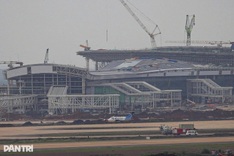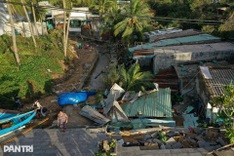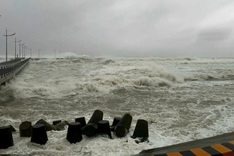A short supply of public rubbish bins is blamed for a rising tide of bagged and unbagged refuse and litter being dumped in the streets of the capital city for municipal cleaners to take away every day.
 |
| Rubbish remains scattered on Ham Long Street in Hanoi despite a rubbish bin within reach |
The local habit of placing rubbish in old plastic bags in the streets has worked against the introduction of plastic bins inside and outside homes and shops. They hold sorted refuse until waste-collection trucks arrive once a week.
The custom is to place everything in the one bag instead of sorting it out as is the practice overseas. Papers and cardboard go in one bin, and plastic and bottles in another. This is later sold for recycling by the collection companies.
Only the tireless efforts of street sweepers and garbage disposal men and women keep Hanoi and most other Vietnamese cities, towns and villages as clean as they are.
While there is generally poor awareness on environmental problems in Vietnam, the shortage of public litter bins is probably the easiest to fix within the existing system.
According to the Asian Green City Index report published early this year by the Economist after a survey of 22 Asian cities, Hanoi ranked below average in its environmental performance, below Kuala Lumpur, Jakarta, Bangkok and Delhi, which were ranked as average.
In a short walk along Ham Long, Ly Thuong Kiet and Hai Ba Trung streets, one can find rubbish thrown in many spots, especially at the foot of trees near food stores or refreshment stands, although litter bins are within sight.
The situation is worse in parks, squares and areas around markets. In suburban areas, many streets do not even have litter bins, and if some do, there are only a few, as local people point out.
"I\'ve never seen a litter bin in my street," said Nguyen Anh Tuan, a resident on Chien Thang Street in Van Quan area in Ha Dong District.
Tuan said the residents in his street often threw rubbish on the corner of the road so that the collection truck would pick it up.
He added that Van Quan Lake, although quite large, had only six to seven litter bins.
Nguyen Van Tam, a resident in Thanh Xuan District\'s Vuong Thua Vu Street, agreed, saying litter bins were not easy to find where he lived.
"I have to go quite far to find a bin, so most of the time I just wait for the environment company\'s rubbish cart to come in the evening to get rid of my household\'s daily garbage," he said.
He said the lack of bins led many pedestrians to throw their rubbish into the streets.
Nguyen Hoang Hiep, communications officer with the Urban Environment One-Member Limited Company, said there were many reasons why some streets had no litter bins.
He said it was partly because of management procedures, partly because some households, specially those doing business in the central streets such as Hang Ngang and Hang Dao, did not want litter bins placed in front of their homes or shops.
Hiep said some people had complained about litter bins being left near their premises and that some even threatened to break them or move them to other places.
"People\'s habits cannot be changed overnight," he said.
In 2010, the Government issued Decree No 73/2010/ND-CP, which stipulates specific fines for violations for polluting the environment. According to the decree, those who throw rubbish into the street will be fined VND100,000-300,000 (approximately USD4.7-14.3).
So far, however, it seems that no one has been fined.
I asked randomly 70 urban residents aged 20-30 who are mostly students and white-collar workers whether they knew of the regulation. More than 50 said they had not.
Some of the rest claimed that they had heard of the decree, but said they did not know about the fines and did not really care because "no one will be fined anyway".
According to Pham Van Khanh, deputy head of the Hanoi Department of Natural Resources and Environment, the problem was caused by a lack of awareness, ineffective communication and poor management.
According to architect Tran Hoang Kien from Vinaconex R&D, a construction company, litter bins should be designed to look the same and placed in the same position (for example, several metres away from housing) every day.
Kien said it was possible to improve the problem, but it depended on whether the authorities really wanted to do it.
Kien cited central Da Nang City as an example of a municipal area with effective management. He said urban planning and people\'s awareness on environment protection were much better there.
In late May, Hanoi approved a VND2.5 trillion ($116,300) city renovation project for the next five years. Some of the money will be spent on installing 10,000 new litter bins.




















